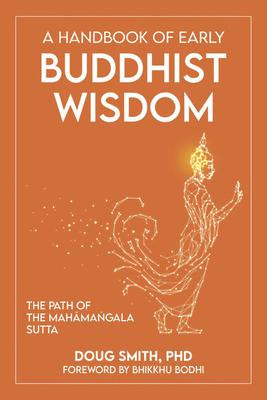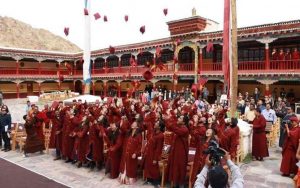
In my previous article, I explored the Sigalovada Sutta (DN 31), a teaching that many have referred to as the “Layperson’s Code of Ethics.” The essay was inspired by—and partially a response to—an article by Amod Lele, in which he raises concerns about the life advocated by the Buddha in his conversation with the layperson Sigala.*
To summarize my article, the Sigalovada Sutta offers a useful roadmap to the contemporary lay Buddhist, as long as they have a teacher or the capacity to dig beyond the specific wording of the instructions to perceive the underlying reasoning behind them. Once one understands the reasoning, the difficult work of applying it to one’s own life begins.
As noted—following from the advice of Buddhist scholar Elizabeth J. Harris—one must find continuity and parallels between the 2,500-year-old teaching and our own lives.
This month, I have the pleasure of reviewing and recommending A Handbook of Early Buddhist Wisdom: The Path of the Mahāmaṅgala Sutta (Akalika Press 2021) by another longtime friend and interlocutor—and also collaborator in two academic articles—Douglass Smith.
The Mahāmaṅgala Sutta (Sn 2.4), as Smith points out, has two great advantages for the modern lay reader. First, it is directed at the laity. Most of the teachings of the Buddha that have been passed down to us are directed at his monastics and thus pertain to a life fully devoted to studying and practicing the teachings, with support from the lay community. And many of the teachings that are directed toward non-monastics are particularly tailored for the circumstances of the individual or people speaking with the Buddha—this was the case with the Sigalovada Sutta, meaning that extra effort is needed for the modern reader to grasp and apply its teachings.
A disadvantage to the Mahāmaṅgala Sutta is that it is very wide-reaching and abstract, thus requiring some effort to apply in the contemporary world. As Ven. Bhikkhu Bodhi writes in his forward to Smith’s book:
As a poem of ten substantial verses, the Mahāmaṅgala Sutta does not offer explanations of the constituents of the good life. Each verse merely mentions, without comment, three or four practices or virtues, indicated by a single word or phrase, and leaves it to the reader or listener to grasp their implications. In the living Buddhist tradition it has thus fallen to preachers and commentators to extract from these expressions their significance in relation to the concrete life conditions of the disciple.
(5)
As a long-time practitioner of the Dharma, study director for the Secular Buddhist Association, creator of the popular YouTube channel “Doug’s Dharma,” and founder of the Online Dharma Institute, Smith offers a widely accessible expression of the teachings found in the sutta.
For instance, Smith notes the lack of appreciation for non-heteronormative approaches to the Dharma (53) as well as the subservience of the female sangha to male monastics (117), and suggests in the latter case that such things can be updated as we realize that a more modern approach to the Buddhadharma is a better fit for our world.
And yet, some things we might not want to modernize or change as they might dilute or distort the Buddha’s revolutionary message. As a sort of test, Smith utilizes the Buddha’s advice in the Gotamiyovāda Sutta (AN 8.53) to Mahāpajāpatī Gotamī, the Buddha’s aunt and step-mother—namely that teachings leading to dispassion, to being unfettered, to modesty, humility, seclusion, and persistence in practice are to be understood as the Buddha’s teaching. Modern readers will recognize a similar teaching in the Kālāmā Sutta (AN 3.65), which instructs lay listeners to follow those teachings that can be seen to lessen one’s greed, hatred, and delusion.
With this methodology—if one would call it that—and a helpful historical introduction, Smith walks the reader through the verses, each of which offers ethical advice for living a good life. The advice itself is at times remarkably similar to that given to Sigala: find good friends, honor upright people, care for your parents, and avoid alcohol. The teaching here goes further at times, adding the cultivation of generosity, listening to the Dharma, and even celibacy to the list of highest blessings.
Depending on our place as a practitioner, these instructions will come as welcome confirmation of our life choices, affirmation of things we need to work on, or challenges to our worldview and approach to the Dharma. If we are lucky—or have good karma—as Smith does, we might be able to book a weekend retreat with one of the world’s foremost teachers, Bhikkhu Bodhi. However, as Smith points out—referencing the American philosopher John Rawls (1921–2002)—this is not the case for most people. However, if we are able to read this text from our phone or computer screen now, or to buy and read Smith’s book, we might say that this too is good karma and we are fortunate.
And so it goes for much of the advice in the sutta—while it presents an ideal that householders or lay practitioners can aspire to, it also invites reflection upon our own situation. How are we doing well already? Is there merit in us in which we can rejoice? Where can we improve? Are there misdeeds we would be wise to confess to a spiritual friend and to work on?

It is this dialog with the great text that a wise reading of the Mahāmaṅgala Sutta invites. And if the text seems distant or unclear, we can rejoice in the teachers, preachers, and secular commentators who are nearer to us to bring the text to life and within our practice. As Smith writes:
The path towards awakening can seem impossibly long and difficult when we look at it from where we are. We look up at a snowy Everest peak from the the hot, tropical lowlands. In such a situation it helps to have a road map, one that points out the important waymarkers and watering holes. Within the Buddhist canon there are many such maps, but most are either cursory or oriented towards monastics. With the Mahāmaṅgala Sutta we have the most complete description of the path, expounded from a largely householder perspective: one that we can all use and understand in daily life.
The path we have been presented with is personal. It involves our own effort and progress. But this should not blind us to the fact that we practice for the benefit of all. By making ourselves less prone to greed, hatred, and ignorance we make the world a better place. By learning to act more skillfully in word and deed we ease the lives of those around us. By promoting kindness, compassion, generosity, and wisdom we help others to live better. If that is all we manage to do in our short lives, perhaps it is enough.
(157)
It is with these words that I wholeheartedly recommend A Handbook of Early Buddhist Wisdom. It is a text that will reward the ardent reader and re-reader, and will be apt for groups of modern practitioners seeking a guided journey into this widely popular Theravāda text.
* The Sigālovāda’s vicious mean (Love of All Wisdom)
See more
A Handbook of Early Buddhist Wisdom: The Path of the Mahāmaṅgala Sutta (Books To Read)
Related features from Buddhistdoor Global
Matters of Mettā and Merit
Love in the Time of Coronavirus, Part One: Refuge
Buddhistdoor View: Cultivating Charity – Lessons for Buddhists From Christianity
Just a Little Awareness!















